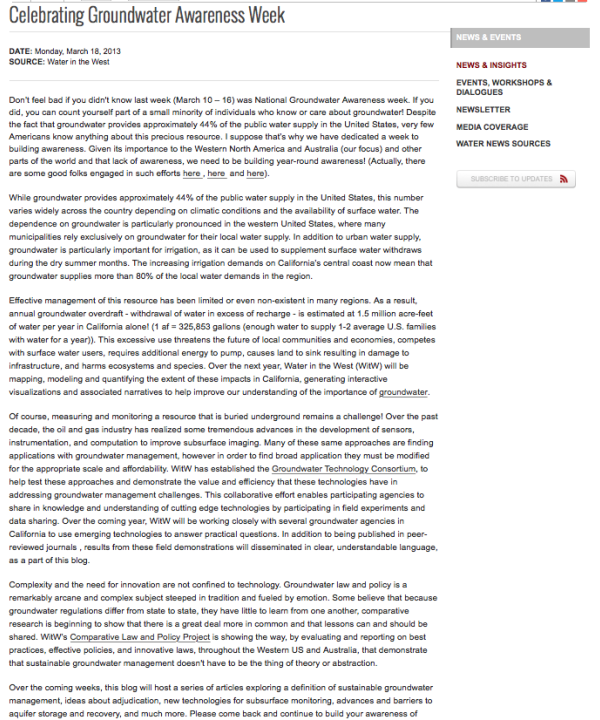March 18, 2013 | Water in the West | Insights
Don’t feel bad if you didn't know last week (March 10 – 16) was National Groundwater Awareness week. If you did, you can count yourself part of a small minority of individuals who know or care about groundwater! Despite the fact that groundwater provides approximately 44% of the public water supply in the United States, very few Americans know anything about this precious resource. I suppose that’s why we have dedicated a week to building awareness. Given its importance to the Western North America and Australia (our focus) and other parts of the world and that lack of awareness, we need to be building year-round awareness! (Actually, there are some good folks engaged in such efforts here
While groundwater provides approximately 44% of the public water supply in the United States, this number varies widely across the country depending on climatic conditions and the availability of surface water. The dependence on groundwater is particularly pronounced in the western United States, where many municipalities rely exclusively on groundwater for their local water supply. In addition to urban water supply, groundwater is particularly important for irrigation, as it can be used to supplement surface water withdraws during the dry summer months. The increasing irrigation demands on California’s central coast now mean that groundwater supplies more than 80% of the local water demands in the region.
Effective management of this resource has been limited or even non-existent in many regions. As a result, annual groundwater overdraft - withdrawal of water in excess of recharge - is estimated at 1.5 million acre-feet of water per year in California alone! (1 af = 325,853 gallons (enough water to supply 1-2 average U.S. families with water for a year)). This excessive use threatens the future of local communities and economies, competes with surface water users, requires additional energy to pump, causes land to sink resulting in damage to infrastructure, and harms ecosystems and species. Over the next year, Water in the West (WitW) will be mapping, modeling and quantifying the extent of these impacts in California, generating interactive visualizations and associated narratives to help improve our understanding of the importance of groundwater.
Of course, measuring and monitoring a resource that is buried underground remains a challenge! Over the past decade, the oil and gas industry has realized some tremendous advances in the development of sensors, instrumentation, and computation to improve subsurface imaging. Many of these same approaches are finding applications with groundwater management, however in order to find broad application they must be modified for the appropriate scale and affordability. WitW has established the Groundwater Technology Consortium, to help test these approaches and demonstrate the value and efficiency that these technologies have in addressing groundwater management challenges. This collaborative effort enables participating agencies to share in knowledge and understanding of cutting edge technologies by participating in field experiments and data sharing. Over the coming year, WitW will be working closely with several groundwater agencies in California to use emerging technologies to answer practical questions. In addition to being published in peer-reviewed journals , results from these field demonstrations will disseminated in clear, understandable language, as a part of this blog.
Complexity and the need for innovation are not confined to technology. Groundwater law and policy is a remarkably arcane and complex subject steeped in tradition and fueled by emotion. Some believe that because groundwater regulations differ from state to state, they have little to learn from one another, comparative research is beginning to show that there is a great deal more in common and that lessons can and should be shared. WitW’s Comparative Law and Policy Project is showing the way, by evaluating and reporting on best practices, effective policies, and innovative laws, throughout the Western US and Australia, that demonstrate that sustainable groundwater management doesn't have to be the thing of theory or abstraction.
Over the coming weeks, this blog will host a series of articles exploring a definition of sustainable groundwater management, ideas about adjudication, new technologies for subsurface monitoring, advances and barriers to aquifer storage and recovery, and much more. Please come back and continue to build your awareness of groundwater!


![[Woods Logo]](/sites/default/files/logos/footer-logo-woods.png)
![[Bill Lane Center Logo]](/sites/default/files/logos/footer-logo-billlane.png)